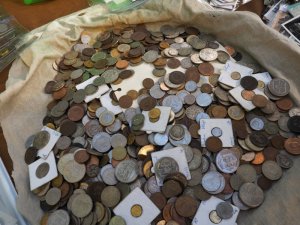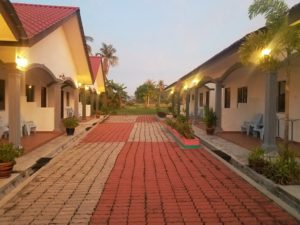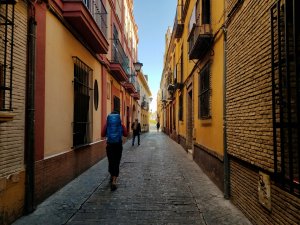Solo travel for extended periods of time is not appealing to everyone, and it can be an intimidating prospect for travelers new to the idea of wandering the world alone. When navigating through the hurdles and frustrations of planning a trip, it’s reasonable to wonder if, perhaps, solo travel is right for you.

To be clear, solo travel is not for everyone. It has plenty of advantages over other types of travel, but there are also a few drawbacks.
However, there a loads of resources – such as hostels and the connections made therein – for travelers thinking about seeing the world on their own. If you’re uncertain, consider the following benefits and obstacles to decide if solo travel is right for you.
Benefits of Solo Travel
There are a lot of benefits to solo travel. I could ramble on for a long time about the specifics and minute details where solo travel has advantages versus traveling with others. To save us all some time, I’ll focus on some of the major benefits of solo travel. These are some of the primary perks of going alone:
- Flexibility – Go when and where you want.
- Eat What You Want – Want spicy local food? No problem. Street food? Go for it. Tired of local food and want a burger or pizza? No one is stopping you.
- Travel Cheaper – Solo travel isn’t always cheaper, but it tends to be more budget-friendly for most travelers when you can afford to be a little selfish.

Considerations
Before you decide if or when to set off on your solo travel adventure, there are a few considerations one must give attention. I encourage all who are able to experience solo travel at some point in their life, even a short weekend away.
Make sure you’re up for solo travel before taking an extended trip abroad. Ask yourself a few important questions:
Where are You Going?
This is an important (and obvious) question. The first step of travel is to figure out where to go.
Some places might not be ideal for solo travel. Cities known to attract couples might not be the best place to spend a week alone. A rugged, rarely-traveled country might not be the best choice for a first-time solo traveler.
Choosing a country/region that aligns with your travel experience is key. Europe and Southeast Asia are hugely popular solo travel destinations for a reason. Don’t drop into the Himalayas or Central Africa alone if you’ve never done any backpacking in comparable locales. Common sense goes a long, long way in solo travel.
On the other hand, some destinations are exceedingly expensive for solo travel. In general, it’s easy to travel cheaper by yourself. There are always exceptions, though, and it would be wise to choose a destination that is reasonable on a solo travel budget.
Make a list of places you want to go. Choose destinations that make sense for solo travel. Save the adventurous backpacking trips until you’re practiced and ready.
For solo travelers, you need to decide how comfortable you are with a particular destination. Getting lost in the sense of aimlessly wandering is great, but being lost and overwhelmed is not fun.
What Kind of Travel Do You Like?
Solo travel and backpacking can be done just about anywhere. Some types of travel are better suited alone, while others are less so.
I like to wander the streets of cities and villages. I take pictures, search for restaurants and explore backstreets. This is usually, to me, best by myself. The same goes for hiking or museums. My preference is to go on my own. I cannot stand being rushed through a museum. And when I’m hiking, as long as it’s safe to do so, I want to go alone and at my own pace.

For the traveler who wants to go shopping, my guess is this person prefers to shop with others. The same is probably true for stereotypical backpackers who want nothing more than to spend their travels partying the days (and nights) away. Sports, especially foreign sports, are better with others. Some things are better with friends.
Consider what types of activities you like to do before deciding on a solo trip. This is a good indicator of whether or not solo travel is right for you.
Do you enjoy doing things and exploring new places on your own? If so, solo travel might be right for you.
Can you handle the potential of essentially being alone for days at a time? Solo travelers aren’t completely devoid of human contact, but there is a reasonable chance that you won’t have any deep, personal connections with other people for extended periods. In my experiences, this rarely lasts long, but it does happen. It’s just too easy to meet nice people in hostels for it to linger too long.

If the idea of hardly having any genuine human connection for a few days scares you, then maybe don’t plan a long solo backpacking trip. Try something shorter first. Give hostels a chance. Ease into solo travel to see if it’s right for you, to see if you can handle the alone time.
Is it Safe?
Is your travel destination safe? How about safety for solo travelers in that locale? These are the most common concerns for travelers prior to going on their first solo adventure.
Most places in the world are safe, often safer than the media portrays (because only the negative stories get attention, especially negative travel stories). For Americans, almost anywhere in the world is statistically safer than Chicago, New Orleans, Baltimore, Detroit – you get the idea.
To be fair, like many places in the world, the unsafe part of these “dangerous” cities is usually nowhere near the tourist areas. More often than not, it’s easy to tell when a neighborhood is sketchy or unsafe. If you feel uncomfortable, that’s okay. Just leave.
As long as you remain aware of your surroundings, mind your pockets, avoid drawing attention to yourself and don’t do something stupid – common sense is especially important for solo travel – safety won’t be an issue.
Crazy things happen. That’s life. And that’s also why travel insurance is important, but employing sound, sensible judgement is the key to travel safety.
When is the Right Time for Solo Travel?
After considering whether or not you should travel solo, the next question is when. For the typical traveler, picking the right time and place to wander alone might not be the easiest decision.
When is the right time for solo travel? Well, that depends. There isn’t a one-size-fits-all approach to travel of any kind.

It’s simpler for younger people to hop on any random flight, such as students on a gap year or in between semesters of school. It is also a lot easier for a young person to justify quitting their job or taking a sabbatical to go and wander the world.
Single travelers – that is, travelers without a significant other – have the freedom to travel without the worry of leaving someone behind. The only feelings to consider are their own. The only schedule to consider is their own.
But young people often cannot afford to travel. And the average single person might not fancy the idea of backpacking for weeks/months all alone. Every traveler has to clear a hurdle or two of some kind before they can hit the road.
Traveling solo usually entails a few additional complications, but there has to be some point that is better to travel. Right? So, when?!
Probably Never
If you’re waiting for the perfect time to go gallivanting around the world by yourself, get comfortable. Because you’re not going anywhere anytime soon. No, you’re probably not going anywhere ever.
There isn’t a perfect time for solo travel. Something will always come up and spoil the fun.
Waiting for the perfect time to set off on that long-awaited solo travel adventure is just waiting for something else to come up and ruin your plans. Natural disasters, labor disputes, political unrest. These things happen.
Oh, and what about those who waited for 2020 to be the perfect year to travel? Hello pandemic and the largest travel shutdown in history!
These are global interrupters, things out of your control and outside your personal life. But events in your own life can affect travel plans, too. Family emergencies, health issues, unexpected opportunities – events out of your control are, well, out of your control.
Waiting for the perfect time to travel is nothing more than waiting for further disappointment. The way I see it, especially as 2020 mocks travelers incessantly, the worst time to travel is “later” or “when life settles down.”
How Important is Travel to You?
If you’re like me, travel is an important part of your life. Even if I wasn’t the Hangry Backpacker, I have no doubt that travel, the next trip and my travel bucket list would still consume a significant amount of my life.
If you’re like that – if travel drives and motivates your daily routine, spending habits, etc – find someone who’s cool with that. Your life will be a lot easier. Whether that person has similar travel desires or is agreeable to your solo travel wanderings, a significant other who accepts your passion to travel is important.
Or, of course, you can stay single. That’s always an effective method to steer clear of conflict and inconvenience, though I’ll be the first to say that some destinations are more enjoyable with someone special.

Big life changes like careers, marriages and children put a damper on loads of travel plans. Some of us want those things and to wander about the world for long periods of time. Big life events make solo travel a tricky proposition.
Finding the right balance – honestly, finding the right person – will make life easier as a solo traveler. If traveling the world is on your bucket list, make sure to consider that before you start climbing the corporate ladder or settling down in suburbia.
How About Now?
If you can’t make the time, take the time. There’s no time like the present. It may be trite, but it’s true. The best time to travel is now.
Obviously, global events like the 2020 pandemic require prospective travelers to heed caution. And, to which I can personally attest, the idea of traveling now, ASAP or on a moment’s notice in 2020 was squashed over and over and over again.
The point is that the world is changing rapidly. When the world finally opens back up to travelers – and it will! – don’t hesitate to take the solo travel adventure of your dreams. Don’t waste time with all that silly planning. Who knows what global crisis will pop up next and ruin another set of plans.
Solo travel isn’t complicated, and it doesn’t require months of delicate planning. Maybe some destinations are better during certain seasons, but those are minor considerations. Waiting for the stars to align, hoping for something to magically make solo travel easier – you’ll never leave your couch. The time to travel is now.
The easiest way to determine whether or not solo travel is right for you is pretty straightforward. Go for a trip. Something short, a few days or a week away by yourself. You’ll find out quickly if you like the idea of solo backpacking or long-term wandering around the world.

Hostels are a savior to ease the minds of first-time solo travelers. Of any age! Solo travel doesn’t have to mean being alone.
Even if that isn’t feasible or doesn’t yield a clear answer, it’s still fairly simple. People who want to travel independently, on their own schedule and do what they want to do are ideal candidates for solo travel. Maybe that’s a little selfish, but who cares.
Waiting for others to get their shit together and join you on the road is the epitome of waiting in vain. The best time to travel is now, and solo travel is an excellent way to see and experience the world.
The Hangry Backpacker contains affiliate links. The Hangry Backpacker may receive a small commission for purchases made through these links AT NOT ADDITIONAL COST to you.































You must be logged in to post a comment.